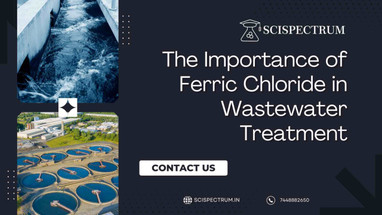Posted by Scispectrum on 22nd Aug 2025
Ferric Chloride: A Key Ingredient in Effective Wastewater Treatment
Clean water is essential for human health and a thriving ecosystem. Yet, every day, industries and municipalities generate vast quantities of wastewater laden with contaminants that pose significant threats to our environment. Enter ferric chloride, a powerful chemical compound playing a crucial role in wastewater treatment plants worldwide. This article delves into the importance of ferric chloride, exploring its applications, benefits, and considerations for ensuring cleaner, safer water for all.
Understanding the Challenges of Wastewater Treatment
Wastewater, a complex mixture of water and dissolved or suspended impurities, presents numerous challenges for treatment facilities. These contaminants include:
- Suspended Solids: Visible particles like sand, grit, and organic matter that affect water clarity and can harbor harmful microorganisms.
- Dissolved Organic Matter: Invisible organic compounds that consume oxygen as they decompose, depleting dissolved oxygen levels essential for aquatic life.
- Nutrients: Excess nitrogen and phosphorus from fertilizers, detergents, and sewage can lead to eutrophication, causing excessive algae growth and harming aquatic ecosystems.
- Pathogens: Wastewater can carry harmful bacteria, viruses, and parasites that pose serious health risks if not effectively removed.
Ferric Chloride: The Coagulation Champion
Ferric chloride (FeCl3), also known as iron(III) chloride, is a highly effective coagulant used extensively in wastewater treatment. Coagulation is a critical step in the treatment process, involving the addition of chemicals to destabilize suspended particles, causing them to clump together and settle out of the water. Here’s how ferric chloride excels in this role:
- Hydrolysis and Charge Neutralization: When ferric chloride is added to wastewater, it undergoes hydrolysis, reacting with water molecules to form iron hydroxide (Fe(OH)3) and hydrogen ions (H+). These iron hydroxide particles have a positive charge, effectively neutralizing the negative charges present on many suspended particles in wastewater.
- Floc Formation: The neutralization of charges allows the destabilized particles to collide and bind together, forming larger, heavier particles called flocs. Ferric chloride promotes the formation of large, dense flocs that settle rapidly, enhancing the efficiency of the treatment process.
Applications of Ferric Chloride in Wastewater Treatment
The versatility of ferric chloride makes it suitable for addressing a wide range of wastewater treatment challenges:
- Removal of Suspended Solids and Turbidity: Ferric chloride effectively removes suspended solids, including silt, clay, and organic matter, significantly improving water clarity and reducing turbidity.
- Reduction of Chemical Oxygen Demand (COD) and Biological Oxygen Demand (BOD): By removing organic matter, ferric chloride helps lower COD and BOD levels, indicators of the amount of oxygen required to decompose organic pollutants in water. Reducing COD and BOD is crucial for protecting aquatic life and preventing oxygen depletion in receiving water bodies.
- Phosphorus Removal: Ferric chloride effectively binds with phosphorus, forming insoluble iron phosphate compounds that precipitate out of the water. This is critical for controlling eutrophication and maintaining healthy aquatic ecosystems.
- Heavy Metal Removal: Ferric chloride can also remove heavy metals, such as lead, mercury, and cadmium, from industrial wastewater. The iron hydroxide flocs effectively adsorb these metals, preventing their discharge into the environment.
- Odor Control and Corrosion Inhibition: Ferric chloride can help control unpleasant odors associated with wastewater by binding with sulfide compounds. It can also form a protective layer on pipes and equipment, inhibiting corrosion and extending their lifespan.
Benefits of Using Ferric Chloride
Several factors contribute to the widespread use of ferric chloride in wastewater treatment:
- High Coagulation Efficiency: Ferric chloride exhibits high coagulation efficiency over a wide pH range, effectively treating various types of wastewater.
- Rapid Floc Formation and Settling: The large, dense flocs formed by ferric chloride settle quickly, improving treatment efficiency and reducing the required size of settling tanks.
- Cost-Effectiveness: Ferric chloride is readily available and relatively inexpensive compared to some other coagulants, making it an economical choice for wastewater treatment facilities.
Considerations for Optimal Use
While ferric chloride is a highly effective treatment chemical, optimizing its use requires careful consideration of several factors:
- Dosage Control: The optimal dosage of ferric chloride depends on the specific characteristics of the wastewater, including pH, alkalinity, and contaminant concentrations. Overdosing can lead to increased sludge production and potential environmental issues, while underdosing may result in incomplete treatment.
- pH Adjustment: The pH of the wastewater can significantly impact the effectiveness of ferric chloride. Adjusting the pH to the optimal range for coagulation is crucial for achieving desired treatment outcomes.
- Sludge Management: The use of ferric chloride generates iron hydroxide sludge, which requires proper management and disposal. Treatment facilities must consider sludge dewatering, disposal options, and potential environmental impacts.
Conclusion: A Critical Component of Clean Water Solutions
Ferric chloride plays a vital role in safeguarding our water resources by effectively removing a wide range of contaminants from wastewater. Its high coagulation efficiency, rapid floc formation, and cost-effectiveness make it a preferred choice for wastewater treatment plants worldwide. As we strive for more sustainable and efficient water management practices, understanding and optimizing the use of ferric chloride will remain crucial for ensuring cleaner, safer water for generations to come.

